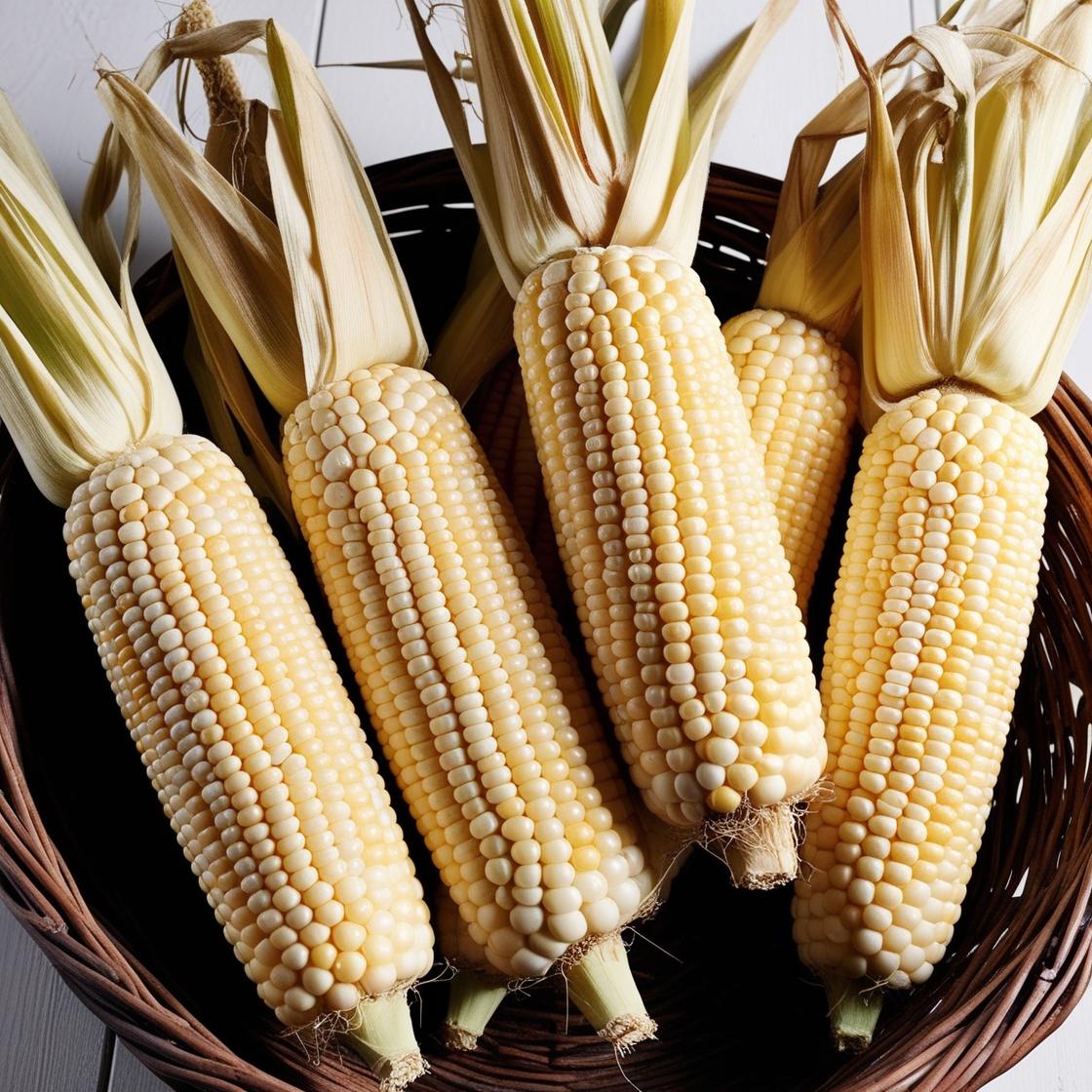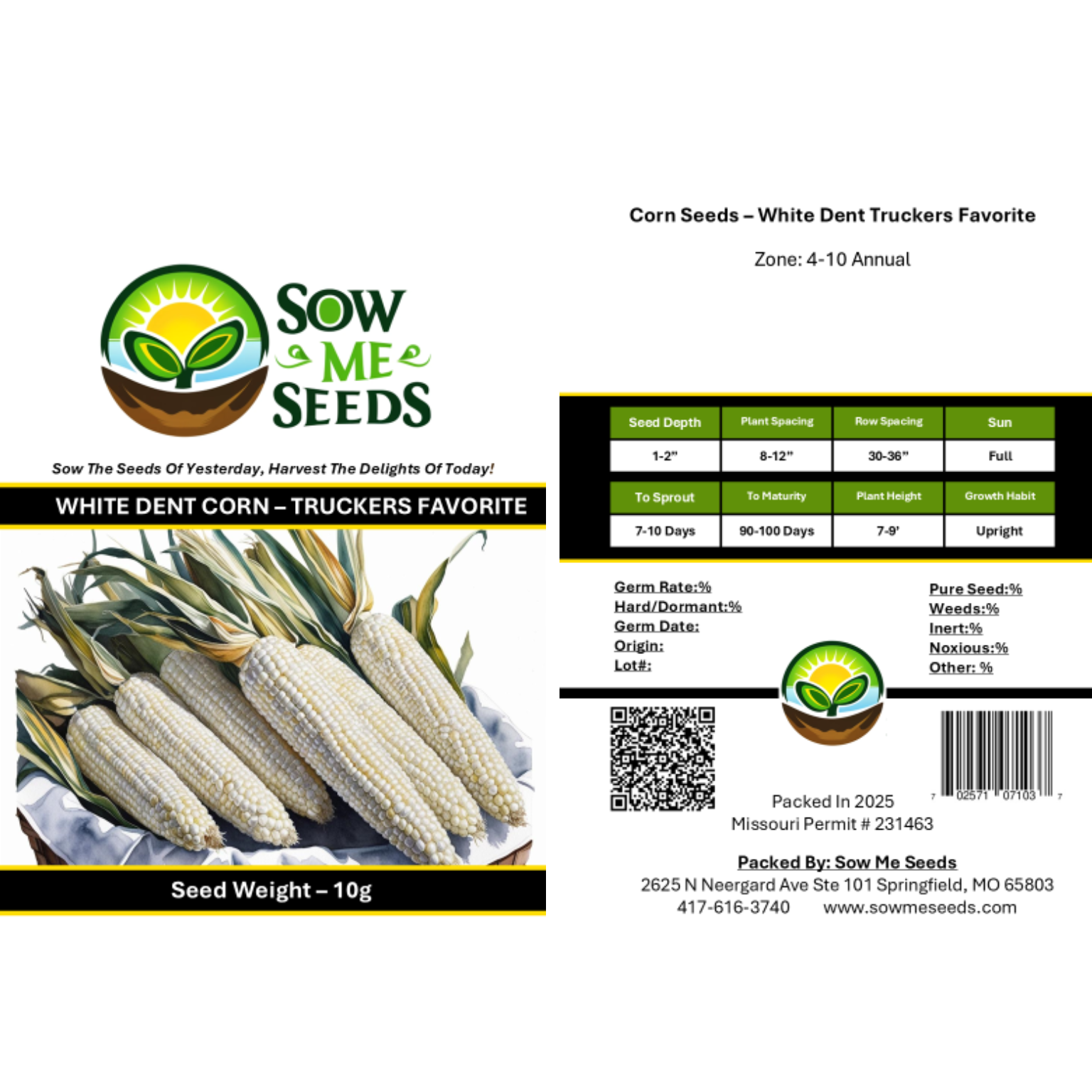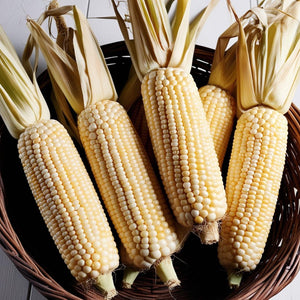- Hardiness Zone: 3-10 Annual
Seed Depth: 1–2 inches
Seed Spacing: 8–12 inches
Row Spacing: 30–36 inches
Sunlight: Full sun
Days to Sprout: 7–10 days
Days to Maturity: 90–100 days
Growth Habit: Upright annual
Sunlight: Thrives in full sun, requiring at least 6–8 hours of direct sunlight daily for optimal growth.
Soil Type: Prefers well-drained, fertile soil with a pH of 6.0–6.8. Enrich soil with compost or aged manure for optimal performance.
When to Plant: Sow seeds directly outdoors after the last frost when soil temperatures reach at least 60°F.
Direct Sowing: Plant seeds 1–2 inches deep, spacing them 8–12 inches apart in rows 30–36 inches apart. Plant in blocks of at least four rows for proper pollination.
Indoor Sowing: Not recommended; direct sowing is ideal for field corn.
Succession Planting: Stagger plantings every 2–3 weeks for an extended harvest.
Watering: Water deeply and consistently, especially during tasseling and ear development. Keep soil evenly moist but avoid waterlogging.
Fertilizing: Apply a nitrogen-rich fertilizer at planting and side-dress with additional fertilizer when plants are 12–18 inches tall.
Pruning: No pruning is required; remove weeds to reduce competition for nutrients.
Pest and Disease Control: Monitor for pests like corn earworms and treat with organic solutions. Prevent fungal diseases by ensuring good airflow and avoiding overhead watering.
When to Harvest: Harvest for fresh use when ears are full and kernels are tender. For dry corn, allow ears to mature fully on the stalk until kernels are hard and the husks are dry.
How to Harvest: Twist ears downward and pull to remove from the stalk.
Seed Collection: Allow ears to fully mature and dry on the stalk. Remove and store seeds from mature kernels.
Storing Seeds: Dry seeds thoroughly and store them in an airtight container in a cool, dry place.
Why You’ll Love It
Large ears: Big, beautiful ears with full rows of white kernels
Dual-purpose: Great for roasting fresh or drying for cornmeal
Heirloom reliability: Time-tested variety with consistent results
Strong stalks: Holds up well in field and garden conditions
Impressive yields: Produces well in a range of soil types
Plant Characteristics
Appearance: Tall green stalks with full, white dented ears
Height: Grows 7–9 feet tall
Growth Habit: Upright and sturdy — space-saving for its size
Flavor and Culinary Uses
Flavor Profile: Mild, sweet at milk stage; nutty and rich when dried
Culinary Uses: Roast fresh, grind for cornmeal or grits, or use in chowders
Best Dishes: Fresh-roasted corn, homemade cornbread, polenta
Companion Planting Tips
Good Companions: Beans, squash, sunflowers, and cucumbers
Avoid Planting Near: Tomatoes and other tall, nutrient-heavy crops
Bonus Benefit: Works beautifully in Three Sisters plantings for a traditional garden layout
Common Issues and Solutions
Corn Earworms: Use organic sprays or add a drop of oil to silks after pollination
Lodging (falling over): Plant in blocks instead of rows for better wind resistance
Poor Pollination: Plant in blocks for better pollen distribution
Weed Competition: Keep beds well-mulched or cultivate early
Seeds Per Packet
| 10g | Approximately 28 |
| 25g | Approximately 70 |
Why You’ll Love It
Large ears: Big, beautiful ears with full rows of white kernels
Dual-purpose: Great for roasting fresh or drying for cornmeal
Heirloom reliability: Time-tested variety with consistent results
Strong stalks: Holds up well in field and garden conditions
Impressive yields: Produces well in a range of soil types
Plant Characteristics
Appearance: Tall green stalks with full, white dented ears
Height: Grows 7–9 feet tall
Growth Habit: Upright and sturdy — space-saving for its size
Flavor and Culinary Uses
Flavor Profile: Mild, sweet at milk stage; nutty and rich when dried
Culinary Uses: Roast fresh, grind for cornmeal or grits, or use in chowders
Best Dishes: Fresh-roasted corn, homemade cornbread, polenta
Companion Planting Tips
Good Companions: Beans, squash, sunflowers, and cucumbers
Avoid Planting Near: Tomatoes and other tall, nutrient-heavy crops
Bonus Benefit: Works beautifully in Three Sisters plantings for a traditional garden layout
Common Issues and Solutions
Corn Earworms: Use organic sprays or add a drop of oil to silks after pollination
Lodging (falling over): Plant in blocks instead of rows for better wind resistance
Poor Pollination: Plant in blocks for better pollen distribution
Weed Competition: Keep beds well-mulched or cultivate early
Seeds Per Packet
| 10g | Approximately 28 |
| 25g | Approximately 70 |




Share and get 15% off!
Simply share this product on one of the following social networks and you will unlock 15% off!